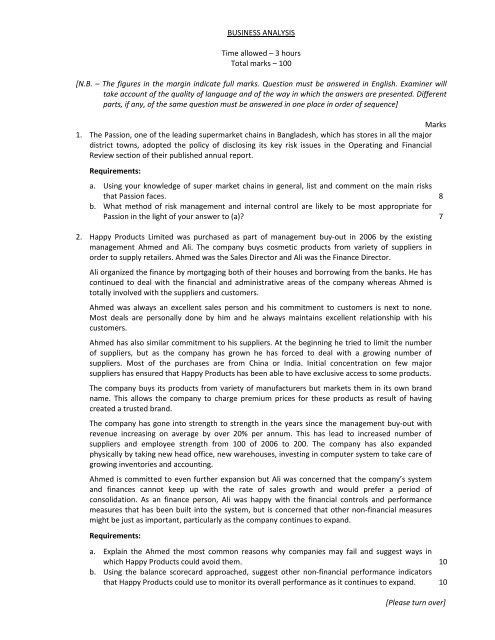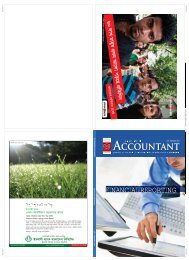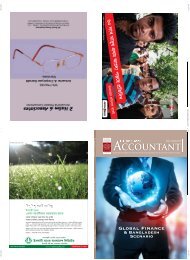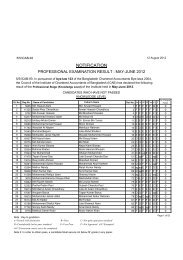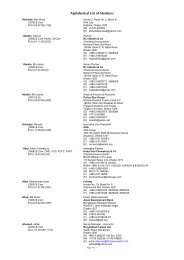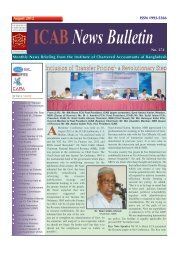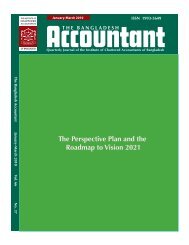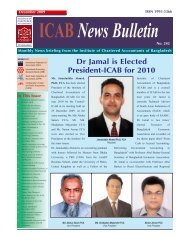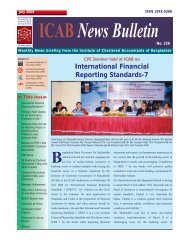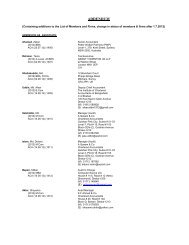BUSINESS ANALYSIS Time allowed â 3 hours Total marks ... - ICAB
BUSINESS ANALYSIS Time allowed â 3 hours Total marks ... - ICAB
BUSINESS ANALYSIS Time allowed â 3 hours Total marks ... - ICAB
Create successful ePaper yourself
Turn your PDF publications into a flip-book with our unique Google optimized e-Paper software.
<strong>BUSINESS</strong> <strong>ANALYSIS</strong><br />
<strong>Time</strong> <strong>allowed</strong> – 3 <strong>hours</strong><br />
<strong>Total</strong> <strong>marks</strong> – 100<br />
[N.B. – The figures in the margin indicate full <strong>marks</strong>. Question must be answered in English. Examiner will<br />
take account of the quality of language and of the way in which the answers are presented. Different<br />
parts, if any, of the same question must be answered in one place in order of sequence]<br />
Marks<br />
1. The Passion, one of the leading supermarket chains in Bangladesh, which has stores in all the major<br />
district towns, adopted the policy of disclosing its key risk issues in the Operating and Financial<br />
Review section of their published annual report.<br />
Requirements:<br />
a. Using your knowledge of super market chains in general, list and comment on the main risks<br />
that Passion faces. 8<br />
b. What method of risk management and internal control are likely to be most appropriate for<br />
Passion in the light of your answer to (a)? 7<br />
2. Happy Products Limited was purchased as part of management buy‐out in 2006 by the existing<br />
management Ahmed and Ali. The company buys cosmetic products from variety of suppliers in<br />
order to supply retailers. Ahmed was the Sales Director and Ali was the Finance Director.<br />
Ali organized the finance by mortgaging both of their houses and borrowing from the banks. He has<br />
continued to deal with the financial and administrative areas of the company whereas Ahmed is<br />
totally involved with the suppliers and customers.<br />
Ahmed was always an excellent sales person and his commitment to customers is next to none.<br />
Most deals are personally done by him and he always maintains excellent relationship with his<br />
customers.<br />
Ahmed has also similar commitment to his suppliers. At the beginning he tried to limit the number<br />
of suppliers, but as the company has grown he has forced to deal with a growing number of<br />
suppliers. Most of the purchases are from China or India. Initial concentration on few major<br />
suppliers has ensured that Happy Products has been able to have exclusive access to some products.<br />
The company buys its products from variety of manufacturers but markets them in its own brand<br />
name. This allows the company to charge premium prices for these products as result of having<br />
created a trusted brand.<br />
The company has gone into strength to strength in the years since the management buy‐out with<br />
revenue increasing on average by over 20% per annum. This has lead to increased number of<br />
suppliers and employee strength from 100 of 2006 to 200. The company has also expanded<br />
physically by taking new head office, new warehouses, investing in computer system to take care of<br />
growing inventories and accounting.<br />
Ahmed is committed to even further expansion but Ali was concerned that the company’s system<br />
and finances cannot keep up with the rate of sales growth and would prefer a period of<br />
consolidation. As an finance person, Ali was happy with the financial controls and performance<br />
measures that has been built into the system, but is concerned that other non‐financial measures<br />
might be just as important, particularly as the company continues to expand.<br />
Requirements:<br />
a. Explain the Ahmed the most common reasons why companies may fail and suggest ways in<br />
which Happy Products could avoid them. 10<br />
b. Using the balance scorecard approached, suggest other non‐financial performance indicators<br />
that Happy Products could use to monitor its overall performance as it continues to expand. 10<br />
[Please turn over]
– 2 –<br />
3. D Ltd. operates in a mature, low‐risk industry and has had a stable level of profit for many years.<br />
Profits after tax for the current year were Tk.120 million and this level of profit is expected to<br />
continue in the future providing the current dividend/retention policy is maintained. The company<br />
adopts a dividend policy based on a dividend payout ratio of 80% and it has just paid a dividend for<br />
the year that has recently ended. However, a newly‐appointed Chief Executive is considering three<br />
new investment strategies will have the same initial investment, they will require different levels of<br />
future investment but will lead to different future growth rates.<br />
The Board of Directors has agreed that if any one of the three new strategies is decided upon the<br />
future investment required will be financed entirely from retained earnings rather than any new<br />
issue of equity. This will entail a reduction in future dividends. Alternatively, the business can<br />
continue its current strategy of high dividend and no growth.<br />
The Board has arranged to meet again in the near future to decide whether to support one of the<br />
proposed strategies or whether to continue with existing strategy of high dividend payments and no<br />
growth. The following figures, which relate to the proposed strategies, will be presented to the<br />
Board at this meeting:<br />
Strategy Dividend payment ratio Growth rate in profits Required return by shareholders<br />
% % %<br />
1 10 8 12<br />
2 30 5 10<br />
3 60 3 9<br />
Requirements:<br />
(a) State, with supporting calculations, what recommendation you would make concerning the<br />
proposed strategies. 8<br />
(b) Explain why the proposed change in dividend policy is likely to be regarded as important by<br />
shareholders. 8<br />
(c) Briefly explain why a company may prefer to fund investment projects by the use of retained<br />
profits rather than by the issue of new equity shares. 4<br />
4. P Ltd. is a wholly‐owned subsidiary of M plc. Although the subsidiary has provided satisfactory levels<br />
of performance, M plc is considering the sale of the subsidiary to another conglomerate. M plc is<br />
experiencing trading problems in other parts of its operations and needs to sell P Ltd. in order to<br />
raise much‐needed finance. The most recent balance sheet of P Ltd. is as follows:<br />
Balance sheet as at 30 November 2009<br />
Fixed assets Tkm Tkm Tk m<br />
Freehold land and buildings at cost 58.5<br />
Less Accumulated depreciation 10.2 48.3<br />
Fixtures and fittings at 8.6<br />
Less Accumulated depreciation 2.9 5.7<br />
Motor vehicles at cost 3.2<br />
Less Accumulated deprecation 1.4 1.8<br />
55.8<br />
Current assets<br />
Stock at cost 49.5<br />
Trade debtors 23.4<br />
Cash at bank 21.5 94.4<br />
Less Creditors: amounts falling due within one year<br />
Trade creditors 25.9<br />
Corporation tax 5.4 31.3 63.1<br />
118.9<br />
Less Creditors: amounts falling due after one year<br />
Debentures 49.0<br />
69.9<br />
[Please turn over]
– 3 –<br />
Capital and reserves<br />
Ordinary Tk.0.50 shares 25.0<br />
Retained profit 44.9<br />
69.9<br />
Extracts from the profit and loss account for the year ended 30 December 2009 are as follows:<br />
Tk. m<br />
Net profit after taxation 10.7<br />
Dividend proposed and paid 3.3<br />
A bid of Tk.3.50 per share for the shares in P Ltd. has been received from L plc. The agreed price<br />
would be paid in shares in the bidding company.<br />
The following details were taken from a financial newspaper concerning the shares of T plc, a similar<br />
business operating in the same industry that is listed on the Stock Exchange and L plc, the<br />
conglomerate company that has made the bid:<br />
2008‐2009<br />
High Low Stock Price ± Dividend (net) Cover (times) Yield (gross) P/E (times)<br />
Tk. 6.40 Tk.5.80 T Tk. 6.15 +5p 12.0p 2.5 2.2 20.5<br />
Tk.10.89 Tk.5.30 L Tk.10.89 +2p 15.0p 3.0 1.5 24.2<br />
An independent valuer has recently estimated the current realizable value of the company’s assets<br />
as follows:<br />
Tk. m<br />
Freehold land and buildings 104.2<br />
Fixtures and fittings 3.5<br />
Motor vehicles 0.4<br />
Stocks 58.0<br />
The balance sheet values of the remaining assets were considered to reflect their net realizable<br />
values. Tax on dividends is at the lower rate of income tax of 10%.<br />
Requirements:<br />
(a) Calculate the value per share of P Ltd. using the following valuation methods: 10<br />
(i) net assets (liquidation) basis;<br />
(ii) dividend yield basis; and<br />
(iii) price/earnings ratio basis.<br />
(b) Briefly evaluate the strengths and weaknesses of each of the share valuation methods set out in<br />
(a) above. 5<br />
(c) Comment on the bid that has been received from L plc and state whether or not the bid should<br />
be accepted. 5<br />
5. A Ltd. (Healthcare) has invested Tk.220,000 over the past two years in the development of a<br />
personal stress‐monitoring device (PSMD). The device is designed for busy individuals wishing to<br />
check their stress levels. Market research that was commissioned earlier in the year at a cost of<br />
Tk.45,000 suggests that the price for the PSMD should be Tk.22 per unit and that the expected<br />
product life cycle of the device is four years.<br />
In order to produce the device, the business must purchase immediately specialist machinery and<br />
equipment at a cost of Tk.300,000. This machinery and equipment has an expected life of four years and<br />
will have no residual value at the end of this period. The machinery and equipment can produce a<br />
maximum of 15,000 PSMDs per year over four years. To ensure that the maximum output is achieved,<br />
the business will spend Tk.50,000 per year in advertising the device over the next four years.<br />
Based on the maximum output of 15,000 units per year, the PSMD has the following expected costs<br />
per unit (excluding the advertising costs above):<br />
Notes Tk.<br />
Materials (1) 6.50<br />
Labour (2) 5.50<br />
Overheads (3) 8.50<br />
20.50<br />
[Please turn over]
Notes:<br />
– 4 –<br />
(1) The materials figure above includes a charge of Tk.2 for a polymer that is currently in stock and<br />
can be used for this project. Each PSMD requires 200 grams of the polymer and the charge is<br />
based on the original cost of Tk.1 per 100 grams for the polymer. It is a material that is currently<br />
used in other areas of the business and the cost of replacing the polymer is Tk.1.50 per 100<br />
grams. The polymer could easily be sold at a price of Tk.1.25 per 100 grams.<br />
(2) The labour costs relate to payments made to employees that will be directly involved in<br />
producing the PSMD. These employees have no work at present and, if the PSMD is not<br />
produced, they will be made redundant immediately at a cost of Tk.230,000. If, however, the<br />
PSMD is produced, the employees are likely to be found other work at the end of the four‐year<br />
period and so no redundancy costs will be incurred.<br />
(3) The figure includes a depreciation charge for the new machinery and equipment. The policy of<br />
the business is to depreciate fixed assets in equal installments over their expected life. All other<br />
overheads included in the above figure are incurred in production of the new device.<br />
The business has a target capital structure of 50% equity and 50% loan capital. The market cost of<br />
equity is 12% and the market cost of loan capital is 8%. The PSMD project has the same level of risk<br />
as that of other projects undertaken and the level of investment required is very small compared to<br />
the size of the business. If the project is accepted, it will be financed entirely by equity.<br />
Ignore taxation.<br />
Requirements:<br />
(a) Calculate the net present value of the project. 15<br />
(b) Calculate the required reduction in annual net cash flows from operations before the project<br />
becomes unprofitable. 5<br />
(c) Comment on your findings in (a) and (b) above. 5<br />
– The End –


